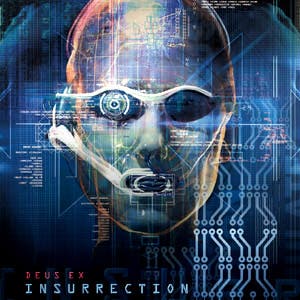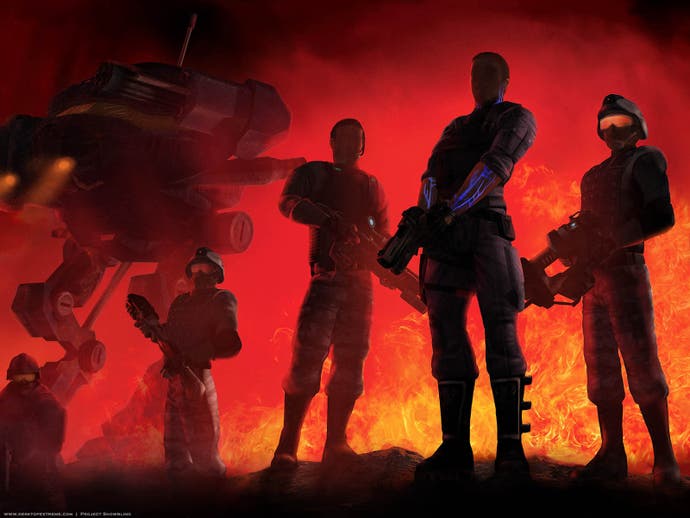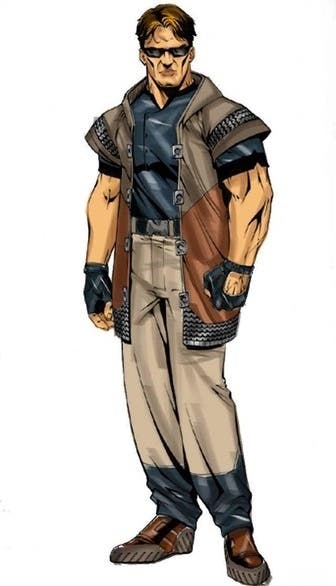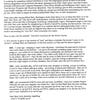Ion Storm's lost Deus Ex Sequels
The missing links.
Invisible War and Human Revolution - these are the sequels every Deus Ex fan knows. But they're only a fraction of the real story. Prior to Human Revolution, Ion Storm Austin, the studio behind the first two Deus Ex titles, worked on a third game in the series. Twice.
Now, exclusive research and interviews offer a look at Ion Storm's creative process and a glimpse at the trilogy that might have been; at the never-announced games known as Deus Ex: Insurrection and Deus Ex 3.
We'll start at the beginning.
Deus Ex: Insurrection - 2003 to 2004
Insurrection's story begins with lead designer, Art Min. Though he first joined Ion Storm as a programmer on Invisible War, Deus Ex 3 was always the real reason behind his recruitment. After Invisible War he was immediately promoted from programmer to project director and given a team of 20 staff with which to create a new Deus Ex game, subtitled Insurrection.
"I moved from Valve specifically to lead the Insurrection team," recalls Min, who took the project through early concept work and halfway through pre-production before things started to go awry.
"We were still in pre-production using the Invisible War engine when things came to a close," says Min. "We had prototypes, concepts and the entire storyline laid out."

Even getting to pre-production wasn't easy. Warren Spector's design notes reveal at least four different storylines were seriously proposed and taken beyond initial brainstorming. Each had it's own theme and place in the Deus Ex timeline; each would have led the franchise in a new direction.
The first, titled 'Save Civilization', cast you as a Black Ops soldier operating on behalf of an incorruptible President. As an eye witness to the destruction of Area 51 in the original game, you'd use cybernetic augmentations to flush out Illuminati agents, restore democracy and set the stage for Invisible War. It was to be a fast-paced globe-trotting adventure, starting with an NSF siege on the White House and touching down in Moscow and London along the way.
Others pitched on a more personal scale. One concept, known as 'Foster Family', grounded a years-long story around a core cast of adopted family members that could bear the consequences of your choices and influence your career within the CIA.
"The more the player succeeds, the more he earns the trust of US officials, many of whom are close friends of his or her fiancé's," explain the notes. "Missions then become riskier and less conventional...[such as] transferring terrorist funds to a Swiss bank account or laser-sighting an American citizen for aerial assassination."
In the Foster Family pitch, family members would constantly offer their thoughts regarding the grand - but oddly undetermined - conspiracy at play.
"I think we can do this as a series of tightly focused missions," reads a final summation that positions Foster Family as the exact opposite of the series' typically sandbox levels. "Each mission might support 2-3 strikingly different states based on earlier choices."
Meanwhile, other proposed plots set Insurrection elsewhere in the timeline. 'Infiltrate The Cult' took place after Invisible War, canonising the JC Denton ending where humanity is linked together by nanite-enabled groupthink. In this story, Paul Denton organises an offline resistance and prolongs his own life using Illuminati cryogenics.
A Door Closes
Ultimately, Min took the project in a different direction to any of the proposals put forward. Insurrection instead became a prequel to the first game, casting you as JC Denton's father/clone, Blake. Again, you'd have been a spy for the US government.
"We wanted to get back to the roots of the original game," says Min. "I wanted real world locations that were relatable, as opposed to a futurist world where things weren't grounded like the original one."
According to Min's story documents, the first mission would begin with the discovery that Chinese forces had covertly infiltrated the US and end with a 'Roswell event' that exposed you to mysterious, human-enhancing technology. It would be unclear where the technology came from but as more events occurred you'd research their origin, gain new abilities and ally with America, China or the EU.
"Other Deus Ex games explored the science fiction of nanotechnology and its social implications," says one draft of the design document. "Insurrection brings the hard science of nanotechnology into a recognisable near-future setting where the stakes are more intuitive without being any less epic."

Positioned as the fourth Deus Ex game due to the then-on-going development of Deus Ex: Clan Wars (later released separately as Project Snowblind), Insurrection used the same engine as Invisible War but distanced itself from its mistakes. Internal documents claim a focus on larger levels and less dialogue as testament to this, alongside mentions of StarCraft: Ghost as a key influence.
More telling than the wider ambitions however are more concretely designed features, some of which later showed up in games inspired by Deus Ex, such as 2010's Alpha Protocol.
"The player... has a home base where he can store gear, re-equip and heal between missions," explains a concept document. "[The home base] is many things: briefing room, rendezvous point, clinic, armoury, moral-compass story space and bridge between missions."
Similar to UNATCO's HQ in the original Deus Ex and the safehouse from Alpha Protocol, the home base would provide a place to explore story through recruitable allies. These allies would align themselves to Insurrection's main factions and respond appropriately - making it difficult to recruit certain combinations or make some choices.
"[In Insurrection] the player builds an elite team that evolves its own personality over time. Will you hire the ace hacker or weapons specialist? Can you trust the gung-ho marine you recruited in New York now you're taking orders from the EU? No one on your team trusts the Chinese nanotech expert - do you fire him or stay the course?"
While the concept document paints an intriguing sketch, it's ultimately unrealised. Drafted in February 2004 and littered with Warren Spector's annotations - one of which tantalisingly just asks 'Online?' - the notes shortly preceded Insurrection's abandonment.
"We had about 12-18 months to go [and] a team of 10-12 when we stopped," says Min, now an executive producer at Rumble Studios. "We had prototypes of new AI behaviour and concept art... I don't recall, but I think we had decided to go back to non-universal ammo too."
"Insurrection came to an end because Warren Spector left Ion Storm. I left shortly after Warren [and] a year later we founded Junction Point Studios together."
Deus Ex 3 - 2004 to 2005
When Insurrection came to an end, it wasn't quite Ion Storm's last gasp. Instead, Jordan Thomas picked up the reins. Under his leadership, Ion Storm's remnants were steered towards a different vision - the never-announced Deus Ex 3.
Kind of, anyway. Thomas' team started work on Deus Ex 3 while Insurrection was still in development, creating a parallel pitch which became legitimised when it outlasted the competition.
Competing teams were apparently not uncommon at Ion Storm, according to Thomas, who implies the studio culture was polarising and often obstructive. Min, who joined first as a programmer so he could get to know the team, presents Ion Storm as down-to-earth - but Thomas describes it as dominated by charismatic individuals rather than practical processes.
"It was basically an auteur cult built around specific personalities," says Thomas, claiming the culture was one of intellectual Darwinism.

"There was a sense we were doing important work. We were convinced Ion Storm had hired the best game designers alive, even though what that really meant was 'white, mainly-male designers who happened to have been filtered through the Looking Glass school of thought'."
As a result, project teams and even Thomas became so siloed that, when I lay the Insurrection notes on the table, he leafs through and admits it's the first time he's seen them.
"This stuff only ever reached us anecdotally. There was overlap between projects, but who the arbiter of it was never became clear. Especially when Warren left. That was a faultline, [because] he wasn't there anymore and there was a large series of layoffs and the culture which survived..."
Becoming rueful, he trails off before restarting with cautious pride.
"Well, the Deus Ex totem was important to everyone's vision of the company and I guess that's where I came in."
Thomas makes no attempt to hide his love for Deus Ex. He makes frequent allusions to how it changed his life and that his entire career was launched out of a desire to work with the team responsible. This likely made him a natural leader for the project - one buoyed up by his then-recent success designing the infamous Shalebridge Cradle level for Thief: Deadly Shadows.
But though Thomas' passion for the series is clear, his vision was radically different to anything the studio had attempted before. To put it plainly, Thomas put the team to work creating the first truly open-world Deus Ex game - one which sacrificed globe-trotting intrigue for a single cyberpunk city; New Orleans.
Three's Company
The first key to Thomas' vision was an entirely new way of telling stories using a generative system which created unique missions derived from your in-game actions. He compares the system to the approach eventually used in Far Cry 2, saying the aim was to create a story which was guided, rather than dictated.
Thomas' story still set the game as a prequel to the original Deus Ex and continued with the idea of casting you as JC's father. The difference was that, in Deus Ex 3, you were a biotech firm's failed experiment. Cast-off by your creators and starting on a literal scrapheap, you'd have no choice but to become a mercenary.
And that's where the generated stories would come in, providing randomised missions that enabled you to climb from experimental reject to the super-soldier of choice for the companies responsible. Eventually, after enough missions, you could stand in the same room as the CEOs that created you - and kill them, if you wanted.

"Deus Ex so abused the immortal NPC flag that we had it so you could kill anyone in the same room as you...[But] we also had a gimmick that kept them alive," says Thomas. He explains that by 'Dixie Flatlining' enemies you could access their memories through your enhancements and force them to be your in-brain counsellor.
Dixie Flatlining - a nod to William Gibson's Neuromancer - would have been important for two reasons. Firstly, it would keep the world semi-populated even if you killed everyone you met. Secondly, it kept narrative nuance in characters other than the player. This would have been vital because Thomas wanted Deus Ex 3 to be more than a revenge fantasy. "I was - and still am - pathologically avoidant of telling players who they are," he says. "I wanted the social hierarchies around each company to be the key mechanic."
Social gameplay and generative storytelling only hints at the ways Deus Ex 3 would have differed from other open-world games. There would have been no vehicles or fast-travelling for example, under the excuse that all cars were DNA-matched to their owners. Vehicles would have been present, but your lack of ID meant they were only useful for throwing at enemies in physics-heavy combat.
Instead, movement across New Orleans would have called for stealth or speed as you hid your crude, visibly robotic enhancements. Jordan describes the stealth as similar to Vampire The Masquerade: Bloodlines, where Nosferatu characters must move through shadows and sewers to hide their monstrous visage. Speedier tactics evoked Crackdown; lots of leaping between rooftops thanks to your augmentations.
Deus Ex 3: The Fall
While Deus Ex 3 was heavily fleshed out on paper however, little of it was ever committed to pixels due to Ion's commitment to Eidos that it would use the Crystal Dynamics engine for all future projects. Ion Storm had previously used it for Deus Ex: Invisible War, where its limitations had been clear in the response from reviewers.
"It was a game centralisation push," says Thomas. "The wisdom at the time was that studios should have one genius technical group within a publisher and everyone should use that tech to avoid complications."
"That wisdom has since been proven false, but we had to show our vision working with that tech. We built an unconvincing technical prototype of the action which involved throwing cars, but the most polished element was the generative story system which James Clarendon was working on."
Ultimately however, the work was for nought. Eidos closed Ion Storm in 2005 following the departure of more key staff and continuing financial failures. Eidos' official statement says it was "consolidating technical and management capabilities into a smaller number of studios capable of scaling up in order to meet the competitive challenges ahead".

An hour into conversation Thomas, seeming irritated he once fell thrall to Ion Storm's charismatic culture, explains the situation more simply.
"We failed. We were supposed to be the best of the best, but the best of the best had failed with [Thief: Deadly Shadows and Deus Ex: Invisible War]. Back to back failures."
"There's a reason the place closed and it was chiefly hubris. There are many people who will tell you that the publisher f***ed us but, no. No. The method failed. Making a smaller, more intimate Deus Ex was on nobodies mind. Including mine."
Thomas believes his aesthetics and methodologies have changed in the years since Deus Ex 3. His current project, The Magic Circle , is a fake remake of a game abandoned by its creator and his first independent game since leaving Ion Storm. A game in which you must piece together story revisions amid a world of deliberately broken code, it's hard not to see The Magic Circle as a jab at failed auteurs - Thomas' younger self included.
"For many years I was sad about my failure with Deus Ex 3. I was convinced I'd be the one - the one to finally slay the dragon Chris Crawford has been chasing all these years."
"I don't believe that now. And I don't miss it."











